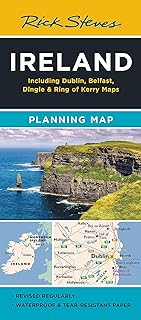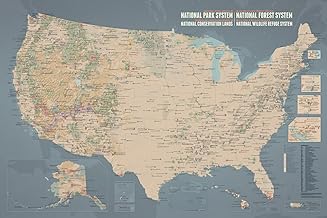5 important factors worth considering when looking for the best maps ever
In today’s world filled with digital tools and GPS systems, physical maps still hold a special charm. Reading maps helps us feel connected to the land we’re exploring, giving us a different view of our trip and where we’re headed. When we buy a map, it’s not just about the drawing – we also think about how good it is, how accurate, and how easy to use. Using a physical map lets us not only enjoy our travels more but also feel a sense of excitement and discovery that technology can’t provide.
See our guide to the best maps ever.
Accuracy
Having accurate maps is very important when it comes to buying them. In today’s digital age, where we have information right at our fingertips, reliable maps are crucial. A map is not just a piece of paper or a digital image; it is a way to see and understand the world around us. Whether we’re planning a trip, finding our way through a city, or learning about different places, accurate maps are like our trusted guides. Paying for maps that have been carefully researched and kept up-to-date shows a commitment to getting things right, which can make our experiences better.
In addition, accuracy in maps is not only about getting the geography correct; it’s also about respecting the different cultures and communities that live in these areas. The way borders, place names, and landmarks are shown on maps holds historical and cultural significance that should be represented truthfully. By choosing maps that have been carefully reviewed and approved, we not only get accurate tools for finding our way but we also help preserve cultural heritage and show respect for indigenous knowledge. In a world where boundaries are always changing and ecosystems are in danger, accurate maps are essential for promoting understanding, awareness, and appreciation for the diverse world we live in.
Scale
When buying maps, it’s important to consider the scale, which affects how much detail and information the map provides. The scale you choose will determine how useful and effective the map is. Picking the right scale is crucial because a map with the wrong scale can cause confusion and frustration, making it less valuable.
Larger-scale maps have more details and accuracy, making them great for exploring specific areas or navigating crowded places. On the other hand, smaller-scale maps cover larger areas but have less detail, making them better for getting a general idea of a place or planning long trips. Knowing how you plan to use the map is important in picking the right scale that fits your needs. Ultimately, the scale of a map acts like a compass, guiding users in their navigation and exploration.
When thinking about map scale, it’s important to find a balance between the amount of information provided and the scope of coverage. While larger-scale maps give a lot of details, they may not be practical for tasks that require a broader view. Conversely, smaller-scale maps give a broad view of large regions but may lack the precision needed for detailed tasks. Finding the right balance between scale and coverage involves thinking about specific needs and preferences. The key is to match the scale of the map to the task at hand, ensuring it gives enough information without overwhelming or underwhelming the user. Essentially, the scale of a map acts as a tool that shapes our understanding of the world around us, providing insights into landscapes, locations, and how everything is interconnected.
Detail
When buying maps, it’s important to pay attention to the small details. The lines, symbols, and labels on a map can really help you navigate and understand different locations. Choosing maps that are very clear and accurate can make a big difference in your experience, whether you’re exploring new areas or planning a trip. These detailed maps not only give you accurate directions but also show you interesting landmarks, terrain, and places to visit. Investing in well-made maps gives you the tools you need to confidently go on adventures and appreciate the world around you even more.
Picking the right map is all about paying attention to the details. Everything from the scale of the map to the symbols and lines on it can help you navigate easily. A good map can provide a lot of information that turns a normal journey into an exciting quest for discovery. By researching thoroughly and paying close attention to the details of different maps, you can make your exploration experience even better. Remember, a map is more than just paper – it’s a key to finding hidden treasures in our world. Paying attention to detail is essential when choosing the perfect guide for your travels.
Paper quality
The type of paper used to print maps can have a big impact on how well they work for you. Maps made with strong, high-quality paper not only look better, but also last longer and are easier to use. Thicker paper with a smooth finish can handle being used often, won’t tear easily, and won’t let ink bleed through, making it a reliable tool for navigating during your travels. Choosing maps made with good paper quality shows that you care about getting accurate information you can rely on for a long time.
On the other hand, saving money by buying maps with low-quality paper could cause problems later on. Thin, weak paper is easy to damage and hard to fold and unfold without ripping or creasing. Maps printed on poor-quality paper are more likely to wear out quickly, making them less useful over time. Picking maps with bad paper quality might make it harder to see details clearly and affect how easy they are to read, making them less helpful. Remember, the quality of the paper a map is made on isn’t just about looks – it’s important for how well the map works and how long it will last.
Purpose
When buying maps, it’s important to have a desire for exploration and adventure. Maps can show us new places and things to discover. Getting a map should make you want to travel and see the world in a new way.
Buying a map should also show a dedication to learning and growing. Maps can teach us about history, geography, and nature. Owning a map is more than just having it; it shows a love for learning and a curiosity about the world around us.
In a world filled with technology, choosing to buy a physical map is a way to respect tradition and the art of map-making. It’s a way to connect with the world in a meaningful way.
Conclusion
In a world where technology is always changing, maps are a useful tool that can be enjoyed by all ages. They don’t just give directions, but also spark a sense of exploration and excitement. As we go through life, maps are like reliable friends that help us navigate through unfamiliar places and lead us back home. They show us the details of our surroundings and the vastness of the world, encouraging us to step out of our comfort zones and embrace new experiences. Maps are more than just pieces of paper or digital images – they represent new opportunities, unexplored territories, and our curiosity and bravery in the face of the unknown as we seek knowledge and adventure. Want more info on charcoal grill, check the best charcoal grill.

